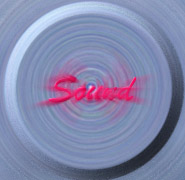
   
|

|

In almost all computers even ones at businesses have
sound. Sound for computers has grown from the think of it
only being useful for games, to being used in
presentations, being part of the operating system, for
entertainment other than games, and is now largely used
for composing and producing music. Sound is processed
through a sound card, which outputs and can record sound.
Multimedia Sound
These steps show how a sound card would take a sound and
record it, is saved to a disk, and is then played back.
1. The sound card takes analog signals from a source
(analog signal being the sound), such as audio from a CD,
and can take more than one signal allowing for stereo.
2. The analog signal is converted to digital data by the
analog-to-digital converter (ADC) chip.
3. A ROM chip takes the signal and gives instructions for
how to process the signal.
4. The ADC sends the digital information to the digital
signal processor (DSP) which processes the information
much like a CPU would. It receives its instructions from
the ROM chip and compresses the signal.
5. The DSP sends the information to the CPU to store on a
drive.
6. To play a saved sound the CPU fetches the file and
sends it to the DSP.
7. The DSP takes the data and decompresses it and sends
it to the digital-to-audio converter (DAC) chip which
converts the digital data to a constantly wavering
electrical current.
8. The analog electric current is amplified and sent out
to whatever is attached to the output, which is almost
always a pair of speakers.
The following two sound output systems are almost alike.
They both use files, called MIDI files, that contain
instructions on what to play, which would include
instruments and how to play them, but do not contain the
actual sounds. The actual sounds are completely produced,
like in the FM Synthesis card, or are take from a stored
list of instruments and notes, such as Wave Table cards,
which also sound better than FM Synthesis.
FM Synthesis
1. Instructions on what to play are sent to the CPU from
a drive.
2. The CPU sends the MIDI information to the digital
signal processor (DSP) which is told what instruments to
play and how they should be played.
3. The DSP then sends the information to the FM synthesis
chip, which uses a mathematical formula to imitate the
instrument and note.
4. The data is finally output through a digital-to-audio
converter (DAC) chip.
Wave Table
1. Instructions on what to play are sent to the CPU from
a drive.
2. The CPU sends the MIDI information to the digital
signal processor (DSP) which is told what instruments to
play and how to play them.
3. The DSP asks for asks for information stored in a ROM
chip of how each instrument sounds. (The ROM chip
contains the actual sounds that are produced by the
instruments.)
4. If a particular note is not contained in the ROM then
the DSP changes a note that is close to what is being
asked for and changes it to the correct note.
5. The information is sent to the digital-to-analog
converter (DAC) chip and is output to some device
(speakers).
|